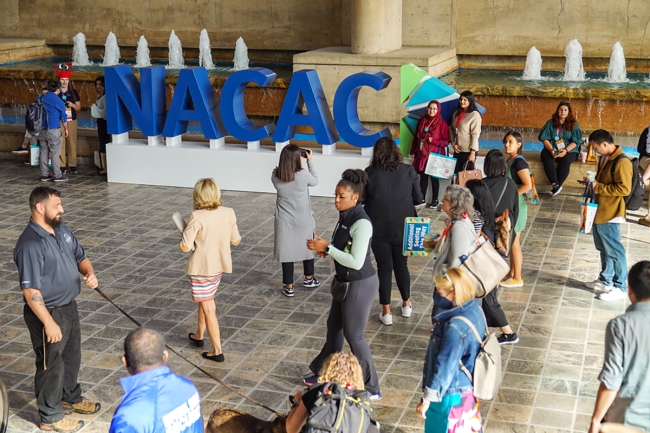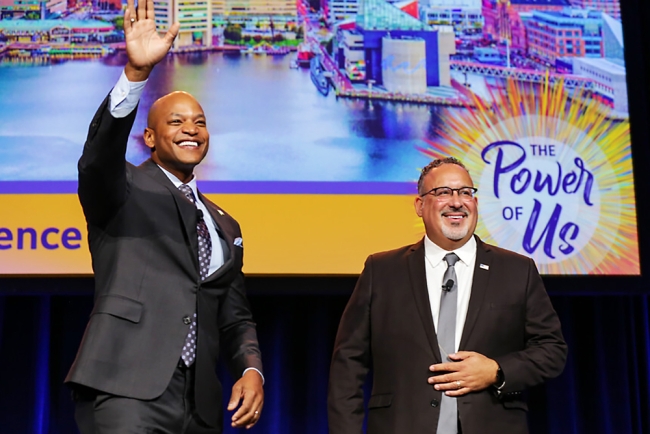You have /5 articles left.
Sign up for a free account or log in.

This year’s national admissions officers’ conference was NACAC’s third-largest ever, reflecting a historic and dynamic time for the profession.
National Association for College Admission Counseling
BALTIMORE—College admissions counselors from across the country gathered here last week for the National Association for College Admission Counseling’ annual conference, where the Supreme Court’s ruling striking down affirmative action—and the future of admissions without it—took center stage.
More than 7,000 people attended the gathering, making it the third-largest conference in the organization’s nearly 100-year history. They brought with them a palpable sense of solidarity and a shared appetite for solutions to complicated problems arising from the tidal wave of changes—including exactly how admissions officers might overcome the potentially devastating effects of this summer’s Supreme Court ruling.
Panels explored how to assess character and identity through admissions essays—a strategy that many colleges seemed to embrace in the immediate aftermath of the decision—as well as the legal dangers of using those essays to try to glean demographic information. Much discussion was devoted to the increasingly important role of race-neutral admissions practices, such as test-optional policies and contextual review to offset the lack of demographic data available to admissions offices. High school counselors in attendance fretted over how to adapt their student coaching for a post–affirmative action era, while college admissions officers participated in hands-on activities simulating the review process without affirmative action.
Discussion also centered on applicants’ socioeconomic status. More than a dozen sessions focused on equity-minded recruitment strategies, from targeting community college transfer students to redeploying resources to underserved ZIP codes.
“The Supreme Court decision did not change precedent on recruitment and outreach,” Eleanor Eckerson Peters, director of research and policy at the Institute for Higher Education Policy, told a ballroom of attendees. “Now is the time to rethink those strategies toward equity.”
The affirmative action decision was not only a logistical concern for the admissions officers in attendance, but it also seemed to underscore a broader assault on the diversity and equity work colleges have long asked of them. At the keynote event on Thursday morning, U.S. Secretary of Education Miguel Cardona drew battle lines in what he painted as a war for the soul and future of education in America.
“You are the front liners in the fight for our kids’ education, for diversity and understanding our history,” he said to raucous applause. “I got a letter from 10 senators last week saying, ‘Stop what you’re doing, promoting diversity; it seems like you’re going against the Supreme Court decision.’ That just strengthened my resolve.”

Maryland governor Wes Moore (left) and U.S. Secretary of Education Miguel Cardona were the conference’s keynote speakers.
National Association for College Admission Counseling
Beyond Affirmative Action
While the Supreme Court decision may have dominated the conference, it wasn’t the only change on the minds of admissions officers in a transformative year for higher education. Other frequent topics of discussions included legacy admissions, test-optional policies and alternative admissions approaches.
Experimental strategies like direct admissions were on display and up for debate in the exposition hall, as advocates and providers sought to capitalize on the appetite for innovative solutions to equity and enrollment challenges.
Luke Skurman, CEO of the admissions platform Niche, which offers direct admissions to 61 institutions, said he’s seen a spike in interest recently as higher ed leaders seek to encourage more students from underresourced high schools to attend college by simplifying what can be an overwhelming application process. Despite recent data from the Common App showing its own direct admissions experiment has not led to higher enrollment, Skurman believes that as the movement grows, it will become an inescapable part of the higher ed landscape.
“There’s a realization that there’s strong traction with students, and with all the change in admissions, that the status quo is not going to work anymore,” he said. “Institutions are coming around to the fact that innovation is necessary.”
Other potential admissions innovations stemmed more obliquely from the Supreme Court ruling. A series of panels at the conference examined the future of standardized testing from all sides, featuring proponents from the College Board and ACT as well as fierce critics who argue the tests privilege white, wealthy applicants.
Jay Rosner, a longtime opponent of standardized testing, gave a concise summation of the current state of standardized testing in higher ed.
“Test optional is the status quo now,” he said. “That train has left the station.”
A Looming FAFSA ‘Nightmare’
Perhaps the most consequential shift aside from affirmative action is the upcoming revision to the Free Application for Federal Student Aid, or FASFA. This year the form is set to launch two months later than usual and include a slew of changes that Congress has billed as “FAFSA simplification.”
Those changes—which include a general overhaul of the form, submission process, need calculations and mechanisms for parental involvement—are likely to increase the number of Pell Grant–eligible students at most institutions but decrease the amount of aid many middle-income students will qualify for.
An afternoon panel on FAFSA simplification nearly reached audience capacity, and it quickly became clear why: the changes seem certain to cause a cascading litany of problems, from angry parents of current students whose aid plummets to delays in acceptances due to the lack of timely financial need information.
“In our office, we’re calling it FAFSA complication,” said panelist Sam Veeder, director of financial aid at the University of Rochester. “It’s going to make things a lot harder to navigate for many families and many of you, and it’s going to be important to get out ahead of it.”
Panel moderator Brett Schraeder, the managing director of financial aid optimization at the marketing and enrollment services provider EAB, said navigating the changes will probably create as much of a headache for institutions as it will for families.
“There are definitely going to be winners and losers, and good for the winners, but the question of how to mitigate the effects for everyone else, and how to make sure it doesn’t affect revenue too much, is going to put a lot of stress on financial aid and admissions offices,” Schraeder told Inside Higher Ed after the panel. “It’s going to be a nightmare.”





